
When Is My Tweet's Prime of Life? (A brief statistical interlude.)
Life's but a walking shadow, a poor player,
That struts and frets his hour upon the stage,
And then is heard no more. -- Macbeth
So, little tweet, how long do you have before you must exit stage left? A minute? An hour?
If you're Obama, well, your record-breaking tweet is probably going to live as long as school kids hate Shakespeare. But, for the rest of us, our tweets probably have the life of a very short-lived fruit fly, right? Right?
Perhaps not!
How can we measure the lifespan of a tweet?
We can't ever really know when a tweet has been "consumed" (to use Twitter's artless term) without access logs. However, we do have a few pieces of information that may help. Notably, retweets.
Retweets are the currency of Twitter. They're a transaction; I've consumed this tweet and find it valuable enough to pass along to others. And, as retweet-like functionality spreads to Facebook and other networks, they're increasingly becoming the currency of the Internet.
We can look at the time retweets occur relative to the underlying tweet for a pretty good signal for how long a tweet "lives." Ultimately, we're not necessarily interested in the old age of a tweet. Rather, with retweets, we can find a tweet's prime of life, when it's youthful and has many courters. Gather ye rosebuds...
Are there any issues using retweets as a prime-of-life metric?
Yep!
First, a retweet probably "kicks the can down the round." When a RT happens, more people may read and retweet the underlying tweet. Therefore, any conclusions we may come to in regards to lifespans of tweets are only for those with RTs. Tweets without RTs have their own hidden lifecycle. While that lifecycle probably correlates strongly, a retweet re-energizes and probably means that RTed tweets have slightly longer lives.
Second, not everyone gets retweeted.
.png)
As we see, as you approach a million followers, pretty much all of your tweets get at least 1 retweet. Those with less than 100 followers have virtually no tweets retweeted.
Why might this be a problem?
RTd tweets from small follower count users may have characteristics that set them apart from their other tweets. Something drove readers to applaud them compared to the many other tweets of theirs that get nary a clap. By comparison, high follower count users could tweet a single word and still count on lots of retweets.
So, bottom-line, this analysis looks at the gems of low follower count users. And, since we're limited to just looking at 100 RTs per tweet, we also rely on the forgettable tweets of high follower count users. Ultimately I don't think this is an issue, but I want to mention it up front.
Drumroll...
Ready for it? The magic number?
Eighteen minutes.
Yep, for half of the users sampled, 18 minutes or less was the time it took for half of their tweets' RTs to occur.
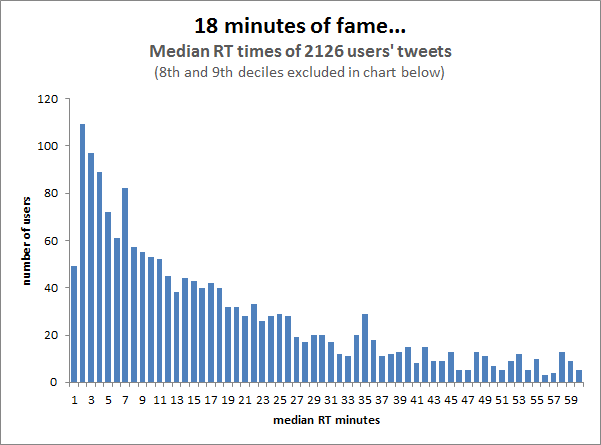
My suspicion was that tweets survived for a minute or so, never to be heard from again after that. Indeed, even following a few hundred users, it's hard to keep up with the tweets that come at you. But generally, tweets live longer than I had imagined. (This 18 minute figure keeps coming up again and again, no matter how you slice the data.)
What's to blame?
Well, nothing! That's just the way it is.
But just as nicotine may knock years off your life, a few things may change your tweets' lifespans significantly. As you'd expect, the number of people who follow you changes things up a bit.
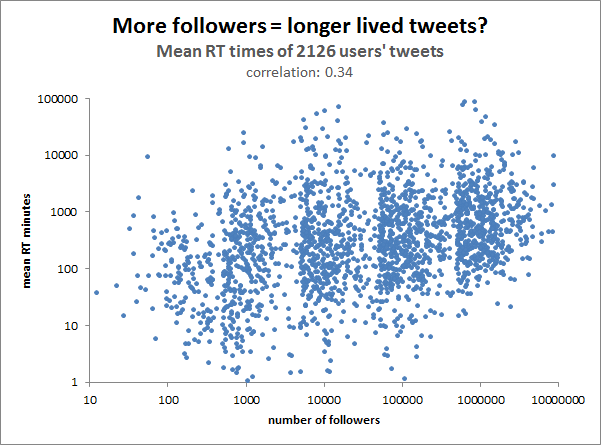
Here, I plot the average retweet time for all users against their follower counts. (Parenthetically, you can see the stratification I did for follower count... yes, we randomly sample, but first we put all Twitter users into buckets by how many follow them. This ensures we also sample from the relatively few high follower count users out there.)
High follower count users have a longer life than low follower count users. Okay, not that surprising. (By the way, it's kind of in vogue to dismiss follower count, but generally it's the most informative and productive metric there is.)
Look a bit closer at the above graph. Note the dispersion on the left, for lower follower count users, is less than on the right, for higher follower count users. If we plot the standard deviations (and I'll save you from that nerdiness), the dispersion is very tight on the right, really disperse on the left. This indicates that there are some low follower count users who hit the ball out of the park. We'll dig more into this in a future post; to find out what it is about some of their tweets that allow them to go big.
Here's something else that seems to impact how long tweets live.
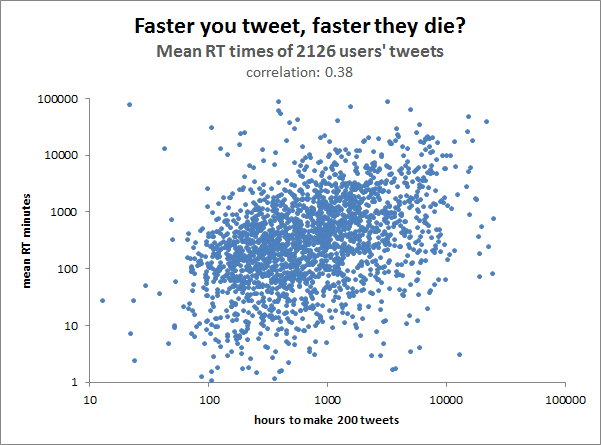
Here, we compare the average lifespan of a tweet to the time it took that user to make 200 tweets. This positive correlation kinda makes sense, too: tweets cannibalize each other. Presumably, the longer a tweet sits at the top of your page, the longer its life. The more you tweet, the shorter the lifespan of each individual tweet.
Can we say this is a causal relationship? No... but it probably is. (If anything, this relationship is probably even stronger.)
You might say to yourself, "Ah, just because tweeting a lot means you drive down the life expectancy of any individual tweet, it doesn't mean that your overall retweet rate will be lower." Perhaps tweeting lots and lots rapidly will garner more overall RTs? The data doesn't bear that out:

Here we see that there's no correlation between how fast you tweet and the total RTs that you get.
Okay, so what else can we investigate?
You know how occasionally those studies come out saying people who use Internet Explorer are less intelligent than Chromers? Okay, well, that was just plain silliness. But perhaps we can learn something by looking at the "source" of the tweet: namely, what client made it. (This is something that Twitter now hides from users, but it is still available via API calls.)
So what do we find?
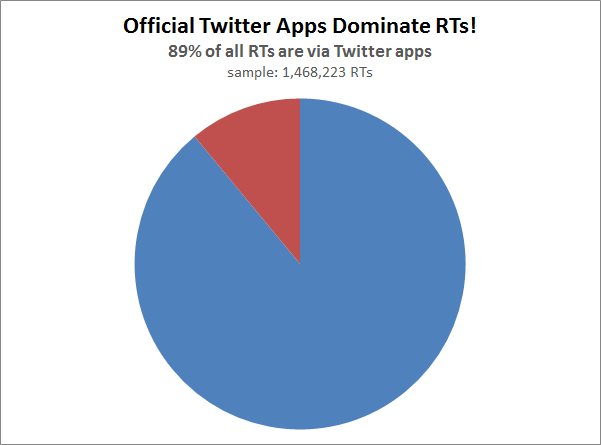
Yeah, so I suppose this isn't that surprising. Almost 90% of all RTs come from official Twitter clients. So much for the salad days of yore, when every developer and his mother published a little Twitter client. We all know that Twitter has, ahem, discouraged that. And it has apparently worked.
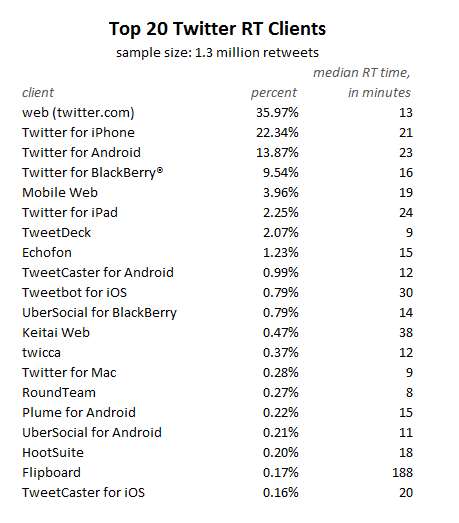
Above is the detail on top RT clients. Here, I looked at 1.3 million retweets. (While the sampling isn't perfect due to the sheer volume of calls that would be required to get a truly random sample, I don't expect that anything would change much with better sampling.)
I also include the median time that users of that client made a retweet. A few things stand out. First, desktop clients are speedy little suckers: note that Tweetdeck and Twitter for Mac both have really fast times. Second, note that Flipboard, a sorta tweet curation service, has a slow response time, which makes sense given that it exposes tweets in report-like "what you missed" format.
I looked at the difference of Flipboard for RTs of tweets by high follower count versus low follower count users. It definitely had more of a presence in high follower count tweets. Similarly, the fast-on-the-draw automatic retweet clients (like RoundTeam) seem to have more of a presence on low follower count tweets (perhaps folks trying to bulk up their influence scores, or engage in other RT exchange programs). Ultimately, though, these clients are so relatively scarce that it's perhaps not worth reading too much into these observations.
Bottom line?
In the next installment, I will dig deeper into both the types of users and tweets that get more retweets. (Please make sure to Like this blog post to encourage me to get started on the next one!)
Here, I wanted to lay the groundwork a bit by looking at retweets as a measure of a tweet's life.
We learned that 18 minutes is an important number. That's the median lifespan of a tweet. Sure, tweets can have an extended old age, with a couple of people continually zapping the tweet back to life. To that end, when you tweet becomes critically important. I recommend that people understand when their audience is online so as to best time your tweets.
In Followerwonk, you can analyze your followers (or those of any other user) and see a chart of when they're most likely to be online. This'll help you find optimal times to tweet.
Parenthetically, it remains an open question, in my ever contrarian mind, that the best time to tweet is the time when most of your followers are online. It almost certainly is. But until tested, I can also make a case that the best time to tweet is when the least amount of your followers are online. Why? Because it's kinda like watching TV at 3 am versus 9 pm. At 3 am you find yourself watching infomercials because there is nothing else on. So, perhaps tweeting at 3 am, when few of your own timezone followers online, will more likely catch those night owl's attention, versus tweeting in the middle of the day when your audience has many other tweeters drawing their attention?
Finally, I think that we've also uncovered a bit of dirt in regards to tweet volume. I don't want to get all correlation versus causation on you, but it seems to be that the faster you tweet, the less life your tweets get. Since it's kinda sad to stamp out the life of a tweet too early, you might consider re-holstering your tweet finger now and again to ensure that you're tweeting quality content at a reasonable rate.
This is a preliminary and brief exploration of Twitter data. Next time, I'll get even nuttier with data. So please "like" this post if you'd like to see more! And don't forget to follow me on Twitter!
The author's views are entirely their own (excluding the unlikely event of hypnosis) and may not always reflect the views of Moz.



Comments
Please keep your comments TAGFEE by following the community etiquette
Comments are closed. Got a burning question? Head to our Q&A section to start a new conversation.